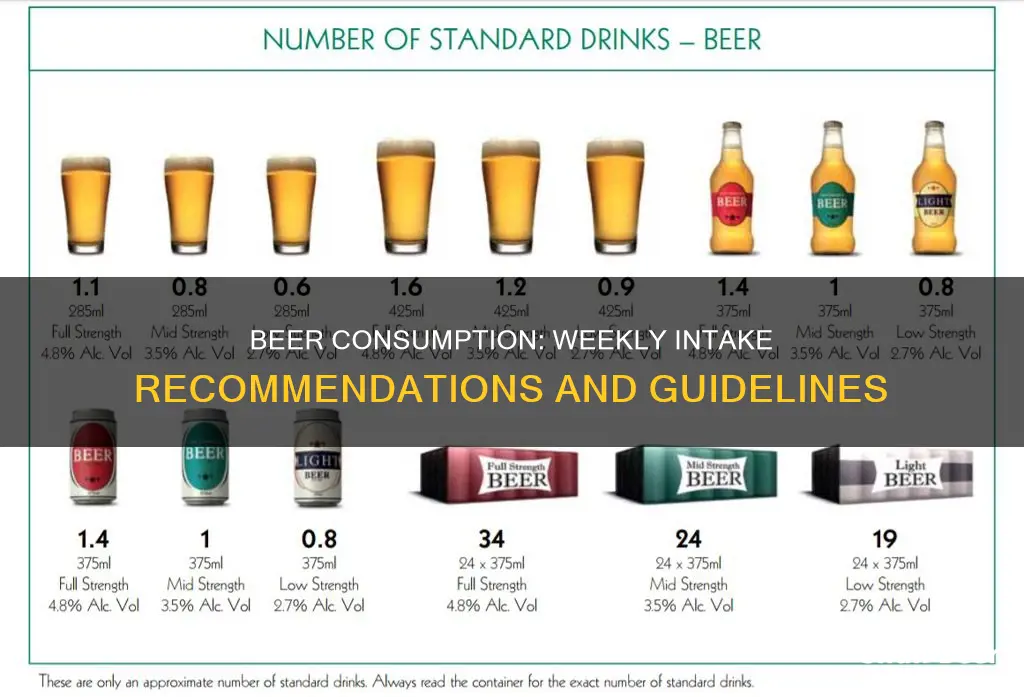
Drinking is a common way to unwind and socialise, but how much is too much? The answer varies from person to person and depends on several factors, including gender, weight, frequency and alcohol by volume (ABV). Generally, drinking guidelines recommend that men should not exceed 14 drinks per week and women should not exceed seven. Binge drinking, which is defined as consuming enough alcohol to reach a blood alcohol concentration (BAC) of 0.08% or higher, is a dangerous practice that can lead to serious health issues. While moderate drinking may offer some health benefits, excessive alcohol consumption increases the risk of chronic diseases, memory problems, mental health issues and social harm. It is important to be mindful of drinking habits to maintain overall health and well-being.
| Characteristics | Values |
|---|---|
| Number of beers considered excessive drinking for men per week | 15 |
| Number of beers considered excessive drinking for women per week | 8 |
| Number of beers considered heavy drinking for men per week | 14 |
| Number of beers considered heavy drinking for women per week | 7 |
| Number of beers considered binge drinking for men (within 2 hours) | 5 |
| Number of beers considered binge drinking for women (within 2 hours) | 4 |
| Number of beers considered excessive drinking for men per day | 5 |
| Number of beers considered excessive drinking for women per day | 4 |
| Number of beers considered heavy drinking for men per day | 4 |
| Number of beers considered heavy drinking for women per day | 3 |
| Number of beers considered risky drinking for men per day | 4 |
| Number of beers considered risky drinking for women per day | 3 |
What You'll Learn

What is considered excessive drinking?
Excessive drinking is a broad term that can vary depending on several factors, such as age, medication, pregnancy, and gender. Generally, excessive drinking includes binge drinking and heavy drinking. Binge drinking is the most common form of excessive drinking, and it is defined as consuming a large amount of alcohol in a single sitting. On the other hand, heavy drinking is defined by the number of drinks consumed over a week.
Binge Drinking
Binge drinking is defined by the Centers for Disease Control and Prevention (CDC) as "a pattern of drinking that brings a person's blood alcohol concentration (BAC) to 0.08 g/dl or above." For men, this typically occurs after consuming five or more drinks within two hours. For women, binge drinking means consuming four or more drinks within the same time frame. Twelve ounces of regular beer equals one standard drink. According to statistics, one in six adults in the United States binge drinks at least four times per month, with men being twice as likely to engage in this behaviour as women.
Heavy Drinking
Heavy drinking is defined as consistently consuming a large number of drinks over the course of a week. For women, this means consuming eight or more drinks per week, while for men, it is defined as consuming 15 or more drinks per week. It is important to note that this does not necessarily mean an individual is binge drinking, as the drinks may be spread out over the week. However, consumption above these standard levels is considered "high" and can lead to serious health consequences.
Consequences of Excessive Drinking
Excessive drinking, whether through binge drinking or heavy drinking, can have numerous negative impacts on both physical and mental health. It increases the risk of unintentional injuries, such as car crashes, violence, and risky sexual behaviours. Additionally, it can lead to memory and learning problems, early and permanent dementia, inflammation and damage to tissues and organs, and chronic diseases such as liver disease, heart disease, stroke, high blood pressure, and cancer. Excessive drinking is also associated with a weakened immune system, higher risk of obesity, and mental health issues such as depression and anxiety.
Guidelines for Low-Risk Drinking
To minimise health risks associated with alcohol consumption, men and women are advised not to drink more than 14 units of alcohol per week on a regular basis. This equates to 14 drinks for men and seven drinks for women per week. It is recommended to spread the drinking over three or more days if drinking up to this amount and to incorporate several drink-free days into the week if aiming to cut down. Additionally, it is important to note that there is no "safe" drinking level, and the less alcohol consumed, the lower the health risks.
Drinking Beer and GHB: What's the Risk?
You may want to see also

What are the consequences of excessive drinking?
Excessive alcohol consumption can have serious consequences for your health, finances, and relationships. Here are some of the potential consequences of drinking too much:
Health Consequences
- Unintentional injuries such as car crashes
- Violence, including domestic violence, sexual assault, and homicide
- Risky sexual behaviours that can result in unintended pregnancy and STIs
- Miscarriage, stillbirth, or fetal alcohol syndrome among pregnant women
- Problems with memory and learning
- Early and permanent dementia
- Inflammation and damage to tissues and organs
- Chronic diseases, including liver disease, heart disease, stroke, high blood pressure, and cancer
- Ulcers and gastrointestinal issues
- Malnourishment and vitamin deficiency
- Weakened immune system
- Higher risk of obesity
- Depression and anxiety
- Other mental health issues, such as psychosis and suicidal thoughts
Personal and Professional Life Consequences
- Decreased productivity at work
- Job loss
- Financial issues
- Problems with friends, family, and romantic relationships
Excessive drinking is defined differently for men and women. For men, it typically involves consuming five or more drinks within two hours or drinking 15 or more drinks per week. For women, excessive drinking involves consuming four or more drinks within two hours or drinking eight or more drinks per week.
Tooth Extraction: Drinking Beer After 24 Hours, Safe?
You may want to see also

How much beer is safe to drink per day?
It's important to remember that alcohol is a drug. While moderate drinking may be linked to certain benefits, such as a reduced risk of heart disease, other research shows no benefit and links moderate drinking to diseases like breast cancer and an increased risk of stroke.
According to the National Institute on Alcohol Abuse and Alcoholism, men should not exceed more than two drinks per day and women should limit themselves to one drink per day. Drinking more than this on a regular basis can put you at risk and often reverse any health benefits of drinking beer.
Exceeding these guidelines is considered "heavy" or "at-risk" drinking and puts you at a higher risk for developing health problems. About 1 in 4 people who drink more than this have an alcohol use disorder.
If you're drinking a 5% beer in a 16-ounce pint, that's 1.3 standard drinks. But a pint of 7% ABV beer is 1.82 standard drinks, which means two pints of 7% beer is actually 3.64 standard drinks.
It's also important to note that drinking the same amount of alcohol divided over several days of a week is better for you than concentrating that amount into one or two days. Giving your liver time to regenerate and heal by taking at least one day off from drinking per week is crucial for maintaining your health.
In summary, if you're wondering how many beers per day is safe, the answer for most people is one to two.
Beer Left in the Car: Still Drinkable?
You may want to see also

How to cut back on drinking beer
Drinking beer in moderation can offer some health benefits, such as lowering your risk of diabetes and heart disease, and increasing bone density in men. However, excessive drinking can have severe consequences for your health, finances, and relationships. So, how much beer is too much?
According to the National Institute on Alcohol Abuse and Alcoholism, drinking in excess of one drink per day for women and two drinks per day for men is considered "heavy" or "at-risk" drinking. Binge drinking is defined as consuming enough alcohol to raise your blood alcohol concentration (BAC) to 0.08% or higher. This typically occurs when a woman consumes four or more drinks within two hours, or when a man consumes five or more drinks within the same period.
If you find yourself drinking excessively, here are some tips to help you cut back on beer:
- Set goals and stick to them: Decide on a realistic target for how much you want to reduce your beer consumption and make sure you celebrate your achievements.
- Cut down on alcohol days: Instead of focusing on units and measurements, try increasing the number of alcohol-free days you have per week.
- Track your drinking: Keep a drinking diary to record when, what, and why you drink. This will help you recognise patterns in your behaviour and reasons that cause you to drink.
- Try alcohol-free socialising: Instead of meeting friends in a pub, suggest alternative activities that don't involve drinking.
- Have a get-out plan: If you do go to a party or social event with alcohol, have a plan. Pre-book a taxi home, only take the amount of alcohol you're comfortable drinking, and don't give in to peer pressure.
- Experiment with relaxation techniques: Try meditating, breathing exercises, or listening to calming music to keep cravings at bay.
- Keep yourself busy: Take up a new hobby or activity to remove temptations to drink.
- Swap your alcohol: Opt for lower-strength beers or wines, or choose a small wine or bottled beer instead of a large glass or pint.
- Keep an alcohol-free house: Avoid keeping alcohol at home to remove temptations.
- Consider a digital detox: Reduce your social media usage, as this can often make you feel like you're missing out on social events where alcohol is involved.
- Deal with cravings: Distract yourself with a book, a walk, or a phone call to a friend or family member when you feel a craving coming on.
- Count the cash: Cutting down on beer will save you money, so treat yourself to something nice with the money you've saved!
Beer and Wisdom Teeth: Safe Drinking Timeline?
You may want to see also

How much beer is too much?
It's important to note that there is no safe amount of alcohol for anyone. However, there are general guidelines that can help determine how much is too much. According to the National Institute on Alcohol Abuse and Alcoholism (NIAAA), to reduce risks, women should limit their intake to one drink or less per day, and men should limit theirs to two drinks or less per day. Drinking more than these recommended amounts is considered "heavy" or "at-risk" drinking and increases the likelihood of developing health problems and alcohol use disorder (AUD).
Excessive drinking can be categorised into binge drinking and heavy drinking. Binge drinking is defined as consuming enough alcohol to raise your blood alcohol concentration (BAC) to 0.08% or higher. For men, this typically occurs after five or more drinks within two hours, while for women, it takes four or more drinks within the same time frame. Heavy drinking is defined as consuming at least eight drinks per week for women and 15 drinks per week for men.
The amount of alcohol considered excessive also depends on the type of beer and its alcohol content. A "standard" drink in the United States contains about 14 grams of pure alcohol, which is typically found in 12 ounces of regular beer (usually 5% alcohol). However, different types and brands of beer can have varying alcohol percentages, with some microbrews containing more than 5%. Therefore, drinking a beer that is 10% alcohol means consuming two "standard" drinks.
Consuming excessive amounts of alcohol can have numerous negative consequences on both physical and mental health. It can increase the risk of unintentional injuries, violence, risky sexual behaviours, memory and learning problems, early dementia, chronic diseases such as liver disease, heart disease, stroke, high blood pressure, cancer, gastrointestinal issues, weakened immune system, and mental health issues such as depression and anxiety. Additionally, excessive drinking can lead to social and professional problems, including decreased productivity, job loss, financial issues, and relationship difficulties.
To summarise, while there is no one-size-fits-all answer to the question of how much beer is too much, it is clear that excessive drinking can have detrimental effects on various aspects of an individual's life. It is important to monitor alcohol consumption and seek help if drinking becomes problematic or difficult to control.
Beer and Gleevec: A Safe Mix?
You may want to see also
Frequently asked questions
Excessive drinking is divided into two categories: binge drinking and heavy drinking. Binge drinking is defined as consuming enough alcohol to raise one's blood alcohol concentration (BAC) to 0.08% or higher. For men, this typically occurs after five or more drinks within two hours, while for women, it takes four or more drinks within the same time frame. Heavy drinking is defined as consuming at least eight drinks per week for women and 15 or more drinks per week for men.
Excessive drinking can lead to a range of serious health issues, including unintentional injuries, violence, risky sexual behaviors, memory and learning problems, early dementia, chronic diseases such as liver disease, heart disease, stroke, high blood pressure, cancer, gastrointestinal issues, a weakened immune system, and mental health issues such as depression and anxiety. It can also cause problems in one's personal and professional life, including decreased productivity at work, job loss, financial issues, and relationship difficulties.
In moderation, drinking beer may offer some health benefits, including a lower risk of diabetes, heart disease, and Alzheimer's or dementia. Moderate drinking is typically defined as one drink per day for women and up to two drinks per day for men.
According to doctors, drinking more than the weekly "upper limits" of alcohol is considered "heavy" or "at-risk" drinking. These limits are four drinks in one day or 14 per week for men, and three drinks in one day or seven per week for women. About one in four people who exceed these limits have an alcohol use disorder.
Recognizing that one's alcohol consumption is excessive is the first step. Setting realistic goals, tracking one's drinking, avoiding triggers, and seeking support from friends, family, or professionals can all help reduce alcohol intake.







